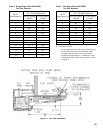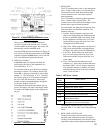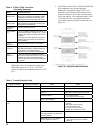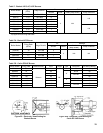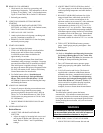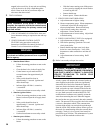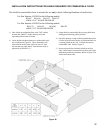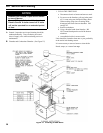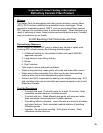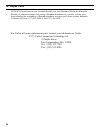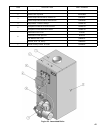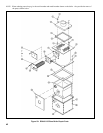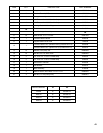
36
trapped in the nozzle line. It may take several ring
cycles for that air to be fully vented through the
nozzle. Water in the fuel or poor ame shape can
also cause shut down noises.
P. TEST CONTROLS
WARNING
Before installation of the boiler is considered
complete, the operation of all boiler controls must
be checked, particularly the primary control and
high limit control.
1. CHECK THERMOSTAT OPERATION. Raise and
lower thermostat setting as required to start and stop
burner.
2. VERIFY PRIMARY CONTROL SAFETY
FEATURES using procedures outlined in
Instructions furnished with control (See back of
Control Cover) or Instructions as follows:
WARNING
Service of this boiler should be undertaken only
by trained and skilled personnel from a qualied
service agency.
a.
Simulate ame failure:
• Follow the starting procedure to turn on the
burner.
• Close the hand valve in the oil supply line.
• Control enters recycle mode and tries
to restart burner after approximately 60
seconds.
• Safety switch should lock out in
approximately 15 seconds. Ignition and
motor should stop.
• Indicator light will ash ½ second on,
½ second off.
• Push red reset button to reset safety switch.
b.
Simulate ignition failure:
• Follow the starting procedure to turn on the
burner, but do not open the oil supply hand
valve.
• Safety switch should lock out in
approximately 15 seconds. Ignition and
motor should stop.
• Indicator light will ash ½ second on,
½ second off.
• Push red reset button to reset safety switch.
c.
Simulate power failure:
• Follow the starting procedure to turn on the
burner.
• With the burner running, turn off the power
to the system by tripping the circuit breaker
or removing the fuse.
• Burner should stop.
• Restore power. Burner should start.
3. VERIFY HIGH LIMIT OPERATION.
a. Adjust thermostat to highest setting.
b. Observe temperature gauge. When temperature
is indicated, adjust limit to setting below
observed temperature. Burner should stop.
c. Adjust limit to setting above observed
temperature. Burner should start.
d. Adjust thermostat to lowest setting. Adjust limit
to desired setting.
4. CHECK LOW WATER CUTOFF (if so equipped).
a. Adjust thermostat to highest setting.
b. With boiler operating, open drain valve and
slowly drain boiler.
c. Burner should stop when water level drops
below low water cutoff probe. Verify limit,
thermostat or other controls have not shut off
boiler.
d. Adjust thermostat to lowest setting. Rell
boiler.
Q. Boiler is now ready to be put into service.
IMPORTANT
IF, DURING NORMAL OPERATION, IT IS
NECESSARY TO ADD WATER MORE FREQUENTLY
THAN ONCE A MONTH, CONSULT A QUALIFIED
SERVICE TECHNICIAN TO CHECK YOUR
SYSTEM FOR LEAKS.
A leaky system will increase the volume of make-up
water supplied to the boiler which can signicantly
shorten the life of the boiler. Entrained in make-up
water are dissolved minerals and oxygen. When the
fresh, cool make-up water is heated in the boiler the
minerals fall out as sediment and the oxygen escapes
as a gas. Both can result in reduced boiler life. The
accumulation of sediment can eventually isolate the
water from contacting the steel. When this happens
the steel in that area gets extremely hot and eventually
cracks. The presence of free oxygen in the boiler creates
a corrosive atmosphere which, if the concentration
becomes high enough, can corrode the steel through
from the inside. Since neither of these failure types are
the result of a manufacturing defect the warranty does
not apply. Clearly it is in everyone’s best interest to
prevent this type of failure. The maintenance of system
integrity is the best method to achieve this.




